User:HaiJohnM/sandbox
| Part of a series on |
| Puzzles |
|---|
 |


A combination puzzle, also known as a sequential move puzzle, is a which consists of a of pieces which can be manipulated into different combinations by a of . Many such puzzles are mechanical puzzles of forme polyhédrale, consisting of multiple layers of pieces along each axis which can rotate independently of each other. Collectively known as twisty puzzles, the archetype of this kind of puzzle is the Cube Rubik. Each rotating side is usually marked with different colours, intended to be scrambled, then solved by a sequence of moves that sort the facets by colour. Generally, combination puzzles also include mathematically defined examples that have not been, or are impossible to, physically construct.
Un puzzle de combinaison, également appelé puzzle à mouvements séquentiels, est un puzzle composé d'un ensemble de pièces qui peuvent être manipulées en différentes combinaisons grâce à un groupe d'opérations. Beaucoup de ces puzzles sont des puzzles mécaniques de forme polyhédrale, composés de plusieurs couches de pièces le long de chaque axe, qui peuvent tourner indépendamment les unes des autres. Collectivement appelés puzzles tournants, l'archétype de ce type de puzzle est le Cube Rubik. Chaque côté tournant est généralement marqué de différentes couleurs, destinées à être mélangées, puis résolues par une séquence de mouvements qui trie les facettes par couleur. En général, les puzzles de combinaison incluent également des exemples mathématiquement définis qui n'ont pas été, ou sont impossibles à, construire physiquement.
Description
[edit]A combination puzzle is solved by achieving a particular combination starting from a random (scrambled) combinaison. Often, the solution is required to be some recognisable pattern such as "all like colours together" or "all numbers in order". The most famous of these puzzles is the original Rubik's Cube, a cubic puzzle in which each of the six faces can be independently rotated. Each of the six faces is a different colour, but each of the nine pieces on a face is identical in colour in the solved condition. In the unsolved condition, colours are distributed amongst the pieces of the cube. Puzzles like the Rubik's Cube which are manipulated by rotating a section of pieces are popularly called twisty puzzles. They are often face-turning, but commonly exist in corner-turning and edge-turning varieties.
Un puzzle de combinaison se résout en atteignant une combinaison particulière à partir d'une combinaison aléatoire (mélangée). Souvent, la solution doit correspondre à un motif reconnaissable tel que « toutes les couleurs similaires ensemble » ou « tous les chiffres dans l'ordre ». Le plus célèbre de ces puzzles est le Rubik's Cube original, un puzzle cubique dans lequel chacune des six faces peut être tournée indépendamment. Chacune des six faces a une couleur différente, mais chacune des neuf pièces d'une face est identique en couleur dans l'état résolu. Dans l'état mélangé, les couleurs sont réparties parmi les pièces du cube. Les puzzles comme le Rubik's Cube, qui sont manipulés en faisant pivoter une section de pièces, sont communément appelés puzzles tournants. Ils sont souvent à rotation de faces, mais existent également sous des formes à rotation de coins et à rotation de bords.
The mechanical construction of the puzzle will usually define the rules by which the combination of pieces can be altered. This leads to some limitations on what combinations are possible. For instance, in the case of the Rubik's Cube, there are a large number of combinations that can be achieved by randomly placing the coloured stickers on the cube, but not all of these can be achieved by manipulating the cube rotations. Similarly, not all the combinations that are mechanically possible from a disassembled cube are possible by manipulation of the puzzle. Since neither unpeeling the stickers nor disassembling the cube is an allowed operation, the possible operations of rotating various faces limit what can be achieved.
La construction mécanique du puzzle définit généralement les règles selon lesquelles la combinaison des pièces peut être modifiée. Cela entraîne certaines limitations sur les combinaisons possibles. Par exemple, dans le cas du Rubik's Cube, il existe un grand nombre de combinaisons qui peuvent être obtenues en plaçant aléatoirement les autocollants colorés sur le cube, mais toutes ces combinaisons ne peuvent pas être obtenues en manipulant les rotations du cube. De même, toutes les combinaisons qui sont mécaniquement possibles à partir d'un cube démonté ne peuvent pas être réalisées par manipulation du puzzle. Étant donné que ni l'arrachage des autocollants ni le démontage du cube ne sont des opérations autorisées, les opérations possibles de rotation des différentes faces limitent ce qui peut être accompli.
Although a mechanical realization of the puzzle is usual, it is not actually necessary. It is only necessary that the rules for the operations are defined. The puzzle can be realized entirely in virtuel space or as a set of mathematical statements. In fact, there are some puzzles that can only be realized in virtual space. An example is the 4-dimensional 3×3×3×3 téseract puzzle, simulated by the MagicCube4D software.
Bien qu'une réalisation mécanique du puzzle soit courante, elle n'est en réalité pas nécessaire. Il suffit que les règles des opérations soient définies. Le puzzle peut être entièrement réalisé dans un espace virtuel ou sous forme d'un ensemble d'énoncés mathématiques. En fait, il existe des puzzles qui ne peuvent être réalisés que dans un espace virtuel. Un exemple est le puzzle téseract 4D 3×3×3×3, simulé par le logiciel MagicCube4D.
Types
[edit]There have been many different shapes of Rubik type puzzles constructed. As well as cubes, all of the polyèdres réguliers and many of the semi-réguliers and stellaires polyhedra have been made.
Il existe de nombreuses formes différentes de puzzles de type Rubik qui ont été conçues. En plus des cubes, tous les polyèdres réguliers ainsi que de nombreux polyèdres semi-réguliers et polyèdres stellaires ont été réalisés.
Regular cuboids
[edit]A parallélépipède is a rectiligne polyèdre. That is, all its edges form right angles. Or in other words (in the majority of cases), a box shape. A regular cuboid, in the context of this article, is a cuboid puzzle where all the pieces are the same size in edge length. Pieces are often referred to as "cubies".
Parallélépipèdes réguliers
[edit]Un parallélépipède est un polyèdre rectiligne. Autrement dit, toutes ses arêtes forment des angles droits. En d'autres termes (dans la majorité des cas), une forme de boîte. Un parallélépipède régulier, dans le contexte de cet article, est un puzzle parallélépipède où toutes les pièces ont la même taille en longueur d'arête. Les pièces sont souvent appelées des « cubies ».
| Picture | Data | Comments |
|---|---|---|
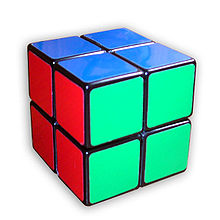
|
Nom commercial : Cube de poche
Forme géométrique : Cube Configuration des pièces : 2×2×2 |
Il est plus facile à résoudre que le cube standard, car seuls les algorithmes pour les pièces de coin sont nécessaires. Cependant, il reste étonnamment non trivial à résoudre. |

|
Nom commercial : Rubik's Cube
Forme géométrique : Cube Configuration des pièces : 3×3×3 |
L'origine de Rubik's Cube |

|
Nom commercial: Rubik's Revenge
Forme géométrique: Cube Configuration des pièces: 4×4×4 |
La solution est essentiellement la même que pour le cube 3×3×3, à l'exception du fait que des algorithmes supplémentaires (et relativement simples) sont nécessaires pour résoudre les pièces centrales et les arêtes, ainsi que pour gérer la parité supplémentaire qui n'est pas présente sur le Rubik's Cube 3×3×3. |

|
Nom commercial: Professor's Cube
Forme géométrique: Cube Configuration des pièces: 5×5×5 |
La solution est essentiellement la même que pour le cube 3×3×3, à l'exception du fait que des algorithmes supplémentaires (et relativement simples) sont nécessaires pour résoudre les pièces centrales et les arêtes. |
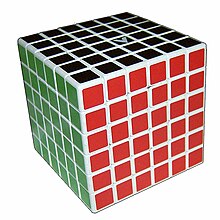
|
Nom commercial: V-CUBE
Forme géométrique: Cube Configuration des pièces: 2×2×2 to 11×11×11 |
Panagiotis Verdes détient un brevet pour une méthode qui serait capable de fabriquer des cubes allant jusqu'à 11×11×11. Il dispose de produits entièrement fonctionnels pour les cubes de 2×2×2 à 9×9×9. |

|
4-Dimensional puzzle
Forme géométrique: Tesseract Configuration des pièces: 3×3×3×3 |
Il s'agit de l'analogue en 4 dimensions d'un cube et, par conséquent, il ne peut pas être réellement construit. Cependant, il peut être dessiné ou représenté par un ordinateur. Il est beaucoup plus difficile à résoudre que le cube standard, bien que les techniques de résolution suivent des principes très similaires. Il existe de nombreuses autres tailles de puzzles parallélépipèdes virtuels allant du trivial 3×3 au 7×7×7×7×7 en 5 dimensions, qui n'a été résolu que deux fois jusqu'à présent.[1]Cependant, le 6×6×6×6×6 n'a été résolu qu'une seule fois, car sa parité ne reste pas constante (en raison de l'absence de pièces centrales appropriées). |
| Non-uniform cuboids
Forme géométrique: Cuboid Configuration des pièces (1st): 2×2×3 Configuration des pièces (2nd): 2×3×3 Configuration des pièces (3rd): 3×4×4 Configuration des pièces (4th): 2×2×6 |
La plupart des puzzles de cette catégorie sont généralement fabriqués sur mesure en petites quantités. La plupart d'entre eux commencent avec le mécanisme interne d'un puzzle standard. Des pièces supplémentaires (cubie) sont ensuite ajoutées, soit modifiées à partir de puzzles standard, soit fabriquées de zéro. Les quatre montrés ici ne sont qu'un échantillon parmi un très grand nombre d'exemples. Ceux avec deux ou trois nombres différents de rangées paires ou impaires ont également la capacité de changer de forme. Le Tower Cube a été fabriqué par Chronos et distribué par la société japonaise Gentosha Education ; c'est le troisième « Okamoto Cube » (inventé par Katsuhiko Okamoto). Il ne change pas de forme, et les couleurs du dessus et du dessous ne se mélangent pas avec les couleurs sur les côtés. | |

|
Siamese cubes
Forme géométrique: Fused cubes Configuration des pièces: two 3×3×3 fused 1×1×3 |
Les cubes siamois sont des puzzles composés de deux ou plusieurs cubes fusionnés de manière à ce que certaines pièces soient communes aux deux cubes. L'image ci-dessus montre deux cubes 3×3×3 qui ont été fusionnés. Le plus grand exemple connu à ce jour se trouve au Puzzle Museum [8] et consiste en trois cubes 5×5×5 fusionnés de manière siamoise, avec une fusion 2×2×5 à deux endroits. Il existe également une version appelée le "fused cube", qui est un assemblage de « 2 cubes 3×3×3 fusionnés avec un 2×2×2 ». Le premier cube siamois a été créé par Tony Fisher en 1981.[9] Cet exemple est considéré comme le premier « puzzle rotatif modifié fait main ».[9] |

|
Nom commercial: Void cube
Forme géométrique: Menger Sponge with 1 iteration Configuration des pièces: 3x3x3-7. |
La solution de ce cube est similaire à celle d'un cube 3×3×3 classique, à l'exception du fait que des combinaisons de parité impaire sont possibles avec ce puzzle. Ce cube utilise un mécanisme spécial en raison de l'absence d'un noyau central. |
 
|
Nom commercial:
Crazy cube type I Crazy cube type II Forme géométrique: Cube Configuration des pièces: 4x4x4. |
Les cercles internes d'un Crazy Cube 4x4x4 se déplacent avec la deuxième couche de chaque face. Sur un Crazy Cube de type I, ils sont connectés de manière interne de telle sorte qu'ils se déplacent essentiellement comme 8 pièces distinctes, et non 24. Pour résoudre ce cube, il faut le considérer comme un 2x2x2 (cube de poche) coincé à l'intérieur d'un 4x4x4 (Rubik's Revenge). Résolvez d'abord le 2x2x2, puis résolvez le 4x4x4 en effectuant uniquement des échanges de pièces. La résolution du type II est beaucoup plus difficile. |
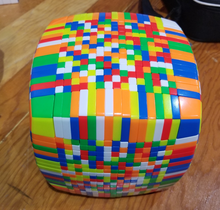
|
Nom commercial: Over The Top
Configuration des pièces: 17x17x17 |
Un cube expérimental fabriqué par impression 3D en plastique, inventé par Oskar van Deventer. Les coins sont beaucoup plus grands en proportion, et les pièces d'arête correspondent à cette dimension plus grande ; elles sont étroites et ne ressemblent pas à des cubes. Le reste des petites pièces du cube (appelées « cubelets ») est organisé en réseaux de 15x15 sur chaque face du cube entier ; comme prévu, chaque cubelet mesure seulement 4 mm de côté. Le mécanisme original repose sur un noyau 3x3x3, avec de fines « pales » pour les arêtes centrales ; le reste des cubelets comble les espaces. Le noyau possède une sphère en son centre. Depuis 2023, il est produit en série par les entreprises chinoises YuXin et Shengshou.[10] |
Pattern variations
[edit]There are many puzzles which are mechanically identical to the regular cuboids listed above but have variations in the pattern and colour of design. Some of these are custom made in very small numbers, sometimes for promotional events. The ones listed in the table below are included because the pattern in some way affects the difficulty of the solution or is notable in some other way.
| Picture | Data | Comments |
|---|---|---|

|
Commercial name: Calendar Cube
Geometric shape: Cube Piece configuration: 3×3×3 |
Mechanically identical to the standard 3×3×3 cube, but with specially printed stickers for displaying the date. Much easier to solve since five of the six faces are ignored. Ideal produced a commercial version during the initial cube craze. Sticker sets are also available for converting a normal cube into a calendar. |

|
Commercial Name: Magic Cube
Geometric shape: Cube Piece configuration: 3×3×3 |
Mechanically identical to the standard 3×3×3 cube. However, the numbers on the centre pieces force the solver to become aware that each one can be in one of four orientations, thus hugely increasing the total number of combinations. The number of combinations of centre face orientations is 46. However, odd combinations (overall odd number of rotations) of the centre faces cannot be achieved with legal operations. The increase is therefore x211 over the original making the total approximately 1024 combinations. This adds to the difficulty of the puzzle but not astronomically; only one or two additional algorithms are required to affect a solution. Note that the puzzle can be treated as a number magic square puzzle on each of the six faces with the magic constant being 15 in this case. |
Sudoku Cube
[edit]The Sudoku Cube or Sudokube is a variation on a Rubik's Cube in which the aim is to solve one or more Sudoku puzzles on the sides or rows. The toy was originally created in 2006 by Jay Horowitz in Sebring, Ohio.[11] It was subsequently produced in China, marketed and sold internationally.

Production
[edit]The Sudoku Cube was invented by veteran toy maker Jay Horowitz, a puzzle inventor who primarily reproduced older toys for the collectibles market.[12][13] Horowitz first encountered the original Sudoku puzzle when a woman sitting next to him on a plane ride explained it to him.[12] After being introduced to the puzzle, Horowitz wanted to introduce the puzzle to the games business, and had the idea of combining it with the Rubik's cube.[13] Horowitz already had access to molds for the Rubik's Cube, as he owned the Ideal Toy Company which owned molds.[12][13] Horowitz worked for a month until he figured out how to combine the two puzzles together, and then when he figured it out, he "did not sleep for three days" while he worked out how to best arrange the numbers to create 18 unique Sudoku puzzles within the cube.[13] Horowitz then patented the numerical design that he created.[13][14] Mass production was completed in China by American Classic Toy Inc, a company belonging to Horowitz.[12][13] The product was sold in the United States in retailers such as Barnes & Noble and FAO Schwarz and sold for $9.87 each.[13] The price was chosen specifically because each number only appears once.[13]
Marketing
[edit]Horowitz promoted his new product in at toy fairs such as the 2007 American International Toy Fair and Hong Kong Toys and Games Fair.[12][13] Adrienne Citrin, the spokeswoman for the Toy Industry Association, mentioned that Sudoku fans who felt like they had mastered the original paper version of the puzzle were interested in the new product.[13] The product was originally launched in the US and then sold internationally, exporting to Spain, France, South Africa and the United Kingdom.[13] Shortly after release, there were several imitator products sold on Amazon under the name "Sudokube".[12]
Irregular cuboids
[edit]An irregular cuboid, in the context of this article, is a cuboid puzzle where not all the pieces are the same size in edge length. This category of puzzle is often made by taking a larger regular cuboid puzzle and fusing together some of the pieces to make larger pieces. In the formulae for piece configuration, the configuration of the fused pieces is given in brackets. Thus, (as a simple regular cuboid example) a 2(2,2)x2(2,2)x2(2,2) is a 2×2×2 puzzle, but it was made by fusing a 4×4×4 puzzle. Puzzles which are constructed in this way are often called "bandaged" cubes. However, there are many irregular cuboids that have not (and often could not) be made by bandaging.
| Picture | Data | Comments |
|---|---|---|

|
Commercial name: Skewb
Geometric shape: Cube Piece configuration: 3x3x3 |
Similar to the original Rubik's Cube, the Skewb differs in that its four axes of rotation pass through the corners of the cube rather than the centres of the faces. As a result, it is a deep-cut puzzle in which each twist scrambles all six faces. |

|
Bandaged Cubes
Geometric shape: Cube Piece configuration: various |
This is a simple example of one a large number of bandaged cube types that have been made.
A bandaged cube is a cube where some of the pieces are stuck together. |
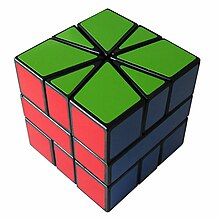
|
Commercial name: Square One
Geometric shape: Cube |
A variation on the original Rubik's Cube where it can be turned in such a manner as to distort the cubical shape of the puzzle. The Square One consists of three layers. The upper and lower layers contain kite and triangular pieces. The middle layer contains two trapezoid pieces, which together may form an irregular hexagon or a square. Square One is an example of another very large class of puzzle — cuboid puzzles which have cubies that are not themselves all cuboid. |
| Golden Cube | Commercial name: Tony Fisher's Golden Cube
Geometric shape: Cube |
First rotational puzzle created that has just one colour,[9] requiring the solver to restore the puzzle to its original cube form without colour aids. |

|
Commercial name: Lan Lan Rex Cube (Flower Box)
Geometric shape: Cube |
|

|
Commercial name: Mixup Cube
Geometric shape: Cube |
Invented by Oskar van Deventer, it looks like a disproportional Rubik's Cube, but it allows the middle layer to turn 45 degrees and swap center pieces with edge pieces. |
Other polyhedra
[edit]| Picture | Data | Comments |
|---|---|---|

|
Commercial Name: Pyraminx
Geometric shape: Tetrahedron Piece configuration: 3×3×3 |
Tetrahedral-shaped puzzle with axes on the corners and trivial tips. It was invented in 1970 by Uwe Mèffert. |

|
Commercial Name: Pyramorphix
Geometric shape: Tetrahedron Piece configuration: 2×2×2 |
Edge turning tetrahedron shaped puzzle with a 2×2×2 cube mechanism. |

|
Commercial Name: Megaminx
Geometric shape: Dodecahedron Piece configuration: 3×3×3 |
12-sided polyhedron puzzle similar to Rubik's Cube in operation and solution. |

|
Commercial Name: Gigaminx, Teraminx, Petaminx
Geometric shape: Dodecahedron Piece configuration: gigaminx is 5x5x5, teraminx is 7x7x7, petaminx is 9x9x9 |
Megaminx variants with multiple layers per face. The Gigaminx has 2 layers per face, for a total of 5 layers per edge; the Teraminx has 3 layers per face, 7 layers per edge; and the Petaminx has 4 layers per face, 9 layers per edge. |

|
Commercial Name: Impossiball
Geometric shape: Rounded icosahedron Piece configuration: 2x2x2 |
Rounded icosahedron puzzle similar to Pocket Cube in operation and solution. |
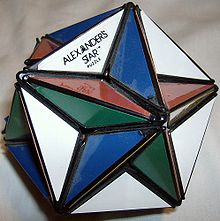
|
Commercial Name: Alexander's Star
Geometric shape: Great dodecahedron Piece configuration: 3x3x3 |
12-sided Nonconvex uniform polyhedron puzzle similar to Rubik's Cube in operation and solution. |

|
Commercial Name: BrainTwist
Geometric shape: Tetrahedron Piece configuration: 2x2x2 |
The BrainTwist is a unique tetrahedral puzzle with an ability to "flip", showing only half of the puzzle at a time. |

|
Commercial Name: Dogic
Geometric shape: Icosahedron Piece configuration: 4x4x4 |
The Dogic is an icosahedron cut into 60 triangular pieces around its 12 tips and 20 face centers. |
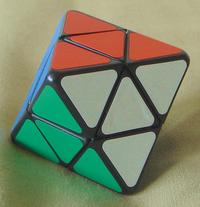
|
Commercial Name: Skewb Diamond
Geometric shape: Octahedron Piece configuration: 3x3x3 |
An octahedral variation on the Skewb, it is a deep-cut puzzle very similar to the Skewb and is a dual-polyhedron transformation. |
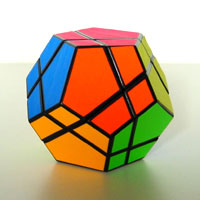
|
Commercial Name: Skewb Ultimate
Geometric shape: Dodecahedron Piece configuration: 3x3x3 |
While appearing more difficult than the Skewb Diamond, it is functionally very similar to the Skewb and Skewb Diamond. The puzzle is cut in a different manner but the same solutions can be used to solve it by identifying what pieces are equivalent. Because faces of the Skewb Diamond correspond to corners of the Skewb Ultimate, an additional constraint on the orientation of these pieces appears. Any Skewb Diamond solution thus requires a few additions in order to solve the Skewb Ultimate. |

|
Commercial Name: Pyraminx Crystal
Geometric shape: Dodecahedron Piece configuration: 3x3x3 |
A dodecahedron cut into 20 corner pieces and 30 edge pieces. It is similar to the Megaminx, but is deeper cut, giving edges that behave differently from the Megaminx's edges when twisted. |
| Commercial Name: Magic 120-cell
Geometric shape: 120-cell Piece configuration: 3×3×3×3 |
Virtual 4-dimensional puzzle, the 4-D analogue of the Megaminx. |
Non-Rubik style three-dimensional
[edit]| Picture | Data | Comments |
|---|---|---|

|
Name: holey burr puzzles with level > 1
Piece configuration: 6 interlocking sticks |
A holey burr puzzle is characterised by internal holes, which usually allow for sliding movements of individual pieces or groups of pieces. The level of a holey burr puzzle specifies how many sliding movements are necessary to assemble or disassemble the puzzle. |

|
Commercial Name: Minus Cube
Piece configuration: 2×2×2-1 sliding cubes |
The Minus Cube is a 3D mechanical variant of the n-puzzle. It consists of a bonded transparent plastic box containing seven small cubes. There is an empty space the size of one small cube inside the box and the small cubes are moveable inside the box by tilting the box causing a cube to fall into the space. |

|
Commercial Name: Rubik's Clock
Piece configuration: 3×3×2 12-position dials |
Rubik's Clock is a two-sided puzzle, each side presenting nine clocks to the puzzler. There are four wheels, one at each corner of the puzzle, each allowing the corresponding corner clock to be rotated directly. There are also four pins next to the center clock, which control the rotation of the four adjacent clock faces. |

|
Commercial Name: Rubik's Snake
Piece configuration: 1x1x24 |
Some would not count this as a combinational puzzle though it bears the Rubik name. Also known as Rubik's Twist. There is no one solution to this puzzle but multiple different shapes can be made.[15] |

|
Commercial Name: Snake Cube
Piece configuration: 1x1x27 or 1x1x64 |
The cubelets are connected by an elastic band running through them. They can rotate freely. The aim of the puzzle is to arrange the chain in such a way that they will form 3 x 3 x 3 or 4 x 4 x 4 cube. |
Two-dimensional
[edit]| Picture | Data | Comments |
|---|---|---|

|
Sliding piece puzzle
Piece configuration: 7×7 |
These ubiquitous puzzles come in many sizes and designs. The traditional design is with numbers and the solution forms a magic square. There have been many different designs, the example shown here uses graphic symbols instead of numbers. The solution requires that there are no repeated symbols in any row, column or diagonal. The picture shows the puzzle unsolved. |
| Sliding piece puzzle with picture
Piece configuration: 7×7 |
Mechanically, no different from the puzzle above. However, the picture on the pieces gives it something of the nature of a jigsaw puzzle, in addition to being a combination puzzle. Note that the picture consists of a multitude of polyhedra which have been made into Rubik puzzles. | |

|
Fifteen puzzle
Piece configuration: 4×4-1 |
The original sliding piece puzzle. |

|
Rubik's Magic | Not entirely 2D. Involves flipping parts back onto itself. |

|
Rubik's Master Magic | The five ringed version of the Rubik's Magic |

|
Commercial name:2D Magic Cube
Geometric shape:Square Piece configuration: 3×3 |
Another virtual puzzle in the Rubik series, but this time a very simple one. |

|
Klotski
Piece configuration: 4×5-2 with some fused pieces |
A traditional sliding piece puzzle. There are now endless variations of this original puzzle implemented as computer games. |
| Geranium
Piece configuration: 5 intersecting circular rotational groups of oddly shaped pieces |
A rotating piece puzzle. Some rank its difficulty very high compared to complex 3D puzzles.[16] There are other versions of this puzzle type including "Mini", "Pocket" and "Super", which have 2, 3 and 10 intersecting circles. There is an "Upgrade" mod which splits some of the large pieces into smaller ones. This puzzle's current production status is unknown. |
Geared puzzles
[edit]| Picture | Data | Comments |
|---|---|---|

|
Gear Cube | This twisty puzzle was invented by Oskar van Deventer. Edge pieces are gears that turn when faces turn and force opposite faces to turn together. Despite its appearance it is considered easier than the Rubik's Cube. |
See also
[edit]References
[edit]- ^ "MagicCube5D Hall of Insanity". Archived from the original on 2016-03-03. Retrieved 2012-02-16.
- ^ "2×2×3 (aka: Slim Tower)". TwistyPuzzles.com. Archived from the original on 2016-03-03. Retrieved 2009-06-12.
- ^ "Tower Cube" (in Japanese). Gentosha Education. Archived from the original on 2016-03-04. Retrieved 2012-05-24.
- ^ "2×3×3". TwistyPuzzles.com. Archived from the original on 2016-03-03. Retrieved 2009-06-12.
- ^ "Rubik's Tower 2×2×4". Archived from the original on 2016-02-03. Retrieved 2012-05-24.
- ^ "Specter Cube". TwistyPuzzles.com. Archived from the original on 2016-03-03. Retrieved 2009-06-12.
- ^ "2×2×6". TwistyPuzzles.com. Archived from the original on 2016-03-04. Retrieved 2009-06-12.
- ^ "Collection of cube puzzles". The Puzzle Museum. January 2003.
- ^ a b c Slocum, Jerry (2009), The Cube. The Ultimate Guide to the World’s Best Selling Puzzles Published by Black Dog & Leventhal Publishers, Inc (ISBN 978-1-57912-805-0)
- ^ "YuXin HuangLong 17x17".
- ^ "US toy maker combines Sudoku and Rubik's Cube amid popularity of brain teasers". International Herald Tribune. 2007-02-17. Archived from the original on 2008-10-15. Retrieved 2008-09-30.
- ^ a b c d e f "US toy maker combines Sudoku and Rubik's Cube amid popularity of brain teasers". International Herald Tribune. 2007-02-17. Archived from the original on 2008-10-15. Retrieved 2008-09-30.
- ^ a b c d e f g h i j k Pawlyna, Andrea (2007). "World Enterprise". World Enterprise. Vol. 4. Archived from the original on 2009-04-03. Retrieved 2024-06-05.
- ^ US patent US2007267813A1, Horowitz, Jay, "Three dimensional sudoku cube puzzle and method", published 2007-05-08, issued 2007-11-22
- ^ Tony Durham, New Scientist, page 209, 9 September 1982
- ^ "top 5 hardest massproduced puzzles". TwistyPuzzles.com Forum.

